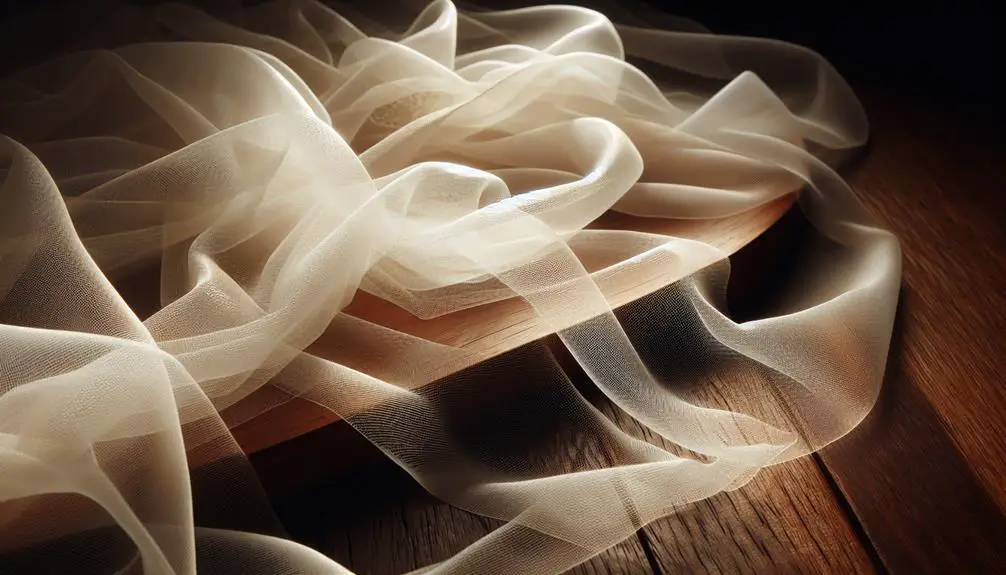Organza gives me a mix of sensations: it's lightweight, almost airy, yet has a crisp texture that's a bit rough to the touch. When I hold it, it feels like it's barely there, but it's surprisingly structured, holding shapes that softer fabrics can't. It's perfect for dresses or decorations that need to stand out without feeling heavy. Whether it's silk or a synthetic version, organza maintains a certain stiffness, ideal for creating voluminous, dramatic looks. If I wear organza, I definitely feel a blend of elegance and drama—almost like wearing a piece of structured air. There's a lot more to discover about how versatile organza can be.
Table of Contents
Key Takeaways
- Organza feels crisp and slightly stiff due to its tightly twisted fibers.
- It has a dry, slightly rough texture from its tight weave.
- Lightweight and airy, organza feels almost like holding air.
- The fabric holds its shape well, providing a structured yet delicate touch.
- When draped, organza maintains a stiff form, standing away from the body.
Understanding Organza's Texture
When you touch organza, its crisp and slightly stiff texture is immediately noticeable. This unique feel comes from its tightly twisted fibers, usually made from silk, polyester, or nylon. It's not just about how it feels but also about understanding why it feels that way. The tight weave and the nature of the fibers give organza a dry, slightly rough texture that's quite different from softer, more fluid fabrics.
Handling organza, I've noticed it doesn't just conform to your skin like cotton or jersey would. Instead, it holds its shape, offering a structured yet delicate touch. This characteristic makes it popular in designs where volume and a light, airy appearance are desired, without the heaviness. It's essential for anyone working with or wearing organza to appreciate this balance of firmness and delicacy to fully exploit its capabilities in fashion and décor.
The Weight and Drape of Organza
While handling organza, I also pay close attention to its weight and how it drapes. Organza is famously lightweight, which is why it's so popular for creating voluminous looks without adding much heft. When I pick up a piece of organza, it's almost like holding air. The fabric itself is so light that it seems to float, and this quality makes it perfect for delicate, airy designs.
The way organza drapes is quite unique. It has a certain stiffness, thanks to its tight weave, which allows it to hold shapes that softer fabrics couldn't. When I drape organza over a mannequin, it doesn't cling or flow like silk or chiffon; instead, it stands away from the body, creating a kind of structured silhouette. This characteristic is fantastic for designers who want to craft garments with a bit of drama and presence.
Because of its light weight and stiff drape, organza is challenging yet rewarding to work with. It demands precision and careful handling, but the results can be stunning. It's all about leveraging its properties to enhance the design, not fighting against them. Understanding these aspects is key to mastering the use of organza in fashion.
Organza's Composition Varieties
Traditional organza is made from silk, giving it a luxurious feel and sheen.
However, there are also modern synthetic options that are more affordable and offer a variety of uses.
Traditional Silk Organza
Among the varieties of organza, traditional silk organza stands out for its luxurious texture and sheer finish. Extracted from silk worms, primarily in Asia, this type of organza is renowned for its strength and natural sheen, which synthetics can't quite match.
I've found that it's not just the appearance that sets it apart; the feel of silk organza is unmistakably smooth and has a slight stiffness, which makes it ideal for more structured garments like wedding dresses and evening gowns. Handling it, you'll notice it's crisp yet delicate, a combination that lends itself beautifully to creating volume without bulk.
It's this unique balance of properties that really defines the allure and practicality of traditional silk organza.
Modern Synthetic Options
Moving beyond traditional silk, modern synthetic organza offers a variety of compositions that cater to different needs and budgets. These materials, such as polyester and nylon, provide a more affordable alternative while maintaining a similar sheer, crisp texture that's characteristic of silk organza.
They're especially great for those of you keen on experimenting with fashion without breaking the bank. Plus, synthetic organza tends to be more durable and less susceptible to moisture damage, making it a practical choice for outdoor events or garments prone to wear and tear. It's fascinating how these synthetics can mimic the beauty of silk so well, yet offer added resilience.
Each type has its unique blend, altering the fabric's feel and performance, so there's always something that'll meet your specific needs.
Durability and Maintenance Tips
Organza's delicate appearance belies its surprising durability, but it does require careful handling to maintain its beauty. To keep your organza items looking their best, there are a few maintenance tips I've found essential.
First, when it comes to washing organza, always opt for hand washing. Use lukewarm water mixed with a gentle detergent. Harsh chemicals can damage the fabric, so it's best to avoid them. After washing, don't wring it out; instead, gently press the water out.
Drying organza is another critical step. Never put it in the dryer. The intense heat can cause shrinkage and even melt certain synthetic versions of the fabric. I always lay my organza flat on a clean towel to air dry. This method helps retain the fabric's shape and texture.
Ironing organza can be tricky. I use a low heat setting and place a pressing cloth between the iron and the fabric to prevent scorching. It's also a good idea to iron on the reverse side to protect the outer texture.
Lastly, storage is key. Don't fold organza; it can create stubborn creases. I hang my organza garments in a cool, dry closet away from direct sunlight to avoid fading. Following these tips, your organza should stay pristine and beautiful.
Organza in Fashion Design
Having covered how to care for organza, let's explore its role in fashion design. Organza has a unique place in the fashion world, primarily due to its crisp yet delicate texture which makes it ideal for creating voluminous silhouettes while maintaining a lightweight feel.
In the realm of haute couture and ready-to-wear collections, designers often turn to organza when they need a fabric that adds drama without the heaviness. It's perfect for layering, which allows designers to play with translucency and structure.
Here's a quick look at some key uses of organza in fashion:
| Use | Benefit | Example |
|---|---|---|
| Evening Wear | Adds volume without weight | Ball gowns |
| Layering | Creates depth and dimension | Multi-layer skirts |
| Bridal | Provides ethereal aesthetics | Wedding dresses |
| Accents | Enhances detail with sheerness | Ruffled collars |
Organza's ability to stand away from the body makes it a favorite for creating bigger, bolder silhouettes that are still elegant. Its sheer nature also means it plays well with light, giving garments a lovely, subtle shimmer. So, it's not just about the look; it's also about the feel and movement of the fabric that truly elevates a design. This makes organza a go-to for designers who want to make a statement while keeping things chic and sophisticated.
Comparing Organza With Other Fabrics
Let's compare organza to other popular fabrics used in fashion design. Organza is known for its sheer, lightweight nature, which provides an ethereal quality unmatched by many fabrics. Unlike heavier materials like velvet or denim, organza gives a delicate, almost floaty feel which is perfect when you're looking for a fabric that offers volume without weight.
Now, if we talk about silk, which is often praised for its luxurious texture, organza, which can also be made from silk fibers, offers a crisper texture due to its tighter weave. This makes it stand out in the structure and form department, especially in designs that require a bit of body and stand-out detailing.
Comparing it to cotton, organza is much less absorbent and doesn't offer the same warmth or softness. Cotton's breathability makes it a go-to for comfort-driven designs, whereas organza's appeal lies in its aesthetic charm rather than practical comfort.
Lastly, when placed side by side with synthetic fabrics like polyester, organza made from natural silk fibers is far superior in terms of environmental impact and sustainability, although synthetic organza is widely available as a more affordable alternative. Each fabric serves its purpose, but organza's unique properties certainly carve its own niche in fashion design.
Ideal Uses of Organza Fabric
Due to its light and airy texture, organza is ideal for creating voluminous evening gowns and wedding dresses. It's sheer and crisp, making it perfect for those layers that need to stand out without weighing down the wearer. I've found that organza adds a touch of elegance and drama to any outfit, especially when you're aiming for a show-stopping look at formal events.
Beyond dresses, organza is also fantastic for crafting airy skirts and blouses that appear both delicate and sophisticated. Its stiffness is a boon for designers who want to maintain a specific silhouette while still offering movement. I love using it for sleeves or as an overlay on skirts because it provides that ethereal quality without compromising on structure.
In home décor, organza works wonders in creating decorative accents like sheer curtains that gently filter light, adding a soft, enchanting glow to any room. It's also popular in crafting festive decorations, such as ribbons and bows, which benefit from its ability to hold shape well.
For anyone mastering the use of fabrics, organza offers a versatile option that elevates projects with its unique blend of elegance and practicality. Whether for fashion or home décor, it's a fabric that adds a special touch to any creation.
Caring for Organza Garments
How do you keep your organza garments looking pristine and beautiful? It's not as tricky as you might think, but it does require some specific care steps to ensure they remain in top condition. First off, always check the care label before you do anything. This can't be stressed enough! Most organza items need to be dry cleaned, but if you're dealing with a blend, you might've different instructions.
If you're washing at home, opt for hand washing with a gentle detergent. Use cold water to prevent shrinkage and maintain the fabric's integrity. Never wring out organza; instead, gently press the water out and lay it flat on a towel to dry. Avoid direct sunlight as it can fade the colors.
When it comes to ironing, set your iron on a low heat and always use a pressing cloth between the iron and the organza to avoid scorch marks or melting the fabric.
Storing organza is straightforward; just make sure it's clean and dry. Use padded hangers to avoid creases and keep it away from rough materials that might snag the fabric. Following these steps, you'll keep your organza garments looking as good as new.
Frequently Asked Questions
Can Organza Fabric Cause Skin Allergies?
Yes, organza can cause skin allergies if you're sensitive to the materials it's made from, like silk or synthetic fibers. I'd recommend checking the fabric content and doing a patch test first.
Is Organza Suitable for Winter Clothing?
I'd say organza isn't ideal for winter clothing because it's lightweight and doesn't provide much insulation. You're better off with thicker fabrics that trap heat and keep you warm in cold weather.
How Does Organza React to Perspiration?
In my experience, organza doesn't handle perspiration well. It can stain and doesn't absorb moisture effectively, making it less ideal for activities or events where you might sweat a lot.
Are There Eco-Friendly Types of Organza Available?
Yes, eco-friendly organza options are available. They're made from sustainable materials like organic silk or recycled polyester. I've found them equally luxurious, yet they leave a lighter footprint on the environment.
Does Organza Offer UV Protection?
I've found that organza doesn't offer significant UV protection due to its sheer, lightweight nature. It's better to look for fabrics specifically designed for sun blocking if you're concerned about UV exposure.
- The History and Evolution of Chamois Fabric - June 22, 2025
- Chamois Fabric on Wikipedia: What You Need to Know - June 22, 2025
- How to Pronounce Chamois Fabric Correctly - June 22, 2025






